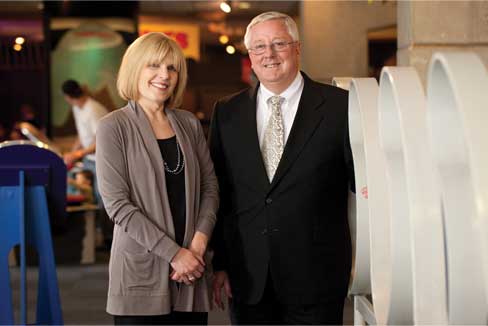 Summer 2010
Summer 2010|
“Our goal is to nurture that scientific curiosity in young people and turn it into an appetite for knowledge.”
|
photo: Joshua FranzosWe’re Boomers—Eisenhower kids born six months apart—so we remember those 1950s predictions about life in the 21st century. There will be so much leisure time in the year 2000, the futurists said, that people will need to look for new ways to expend all the hours in the day. That prophecy was completely off the mark, of course, and downright laughable from our vantage point, with each day filled with endless emails and back-to-back meetings. But we’re lucky to be here at the Science Center: When we’re feeling crunched and over-scheduled, some days we escape our offices and head to the exhibits areas where we can interact with visitors and remind ourselves why we do what we do. A great place to go is our early-learners area on the fourth floor, where preschoolers explore the water tables and ball factory and other excitements. It’s a loud and active place, but if you watch closely you can catch those moments of discovery when a small child comes face-to-face with a box turtle or climbs through a hollow tree trunk. As we say time and again here at the Science Center, the world’s most accomplished scientists were once just curious little kids. Our goal is to nurture that scientific curiosity in young people and turn it into an appetite for knowledge. Our goal—audacious as it may sound—is to grow tomorrow’s workforce in the sciences. Jobs requiring training in STEM courses —science, technology, engineering, and math—will increase 24 percent by the year 2014. That’s more than 1.5 million jobs. If our region is to prosper as a hub of science and technology innovation, we need to assure that our workforce is well-prepared, highly motivated, and inspired to meet the challenges of tomorrow. Currently our region has hundreds of unfilled jobs requiring math, science, and technology skills. Why? Because the needs of area employers extend well beyond the abilities of the young people graduating from our secondary and post-secondary schools. Curiosity is the most basic element of scientific learning and one of the earliest behaviors to develop in young children. It’s a lot easier to maintain that natural curiosity in kids than it is to try to reignite it later, if it has waned. If young people fall behind in the sciences, by middle school it’s often too late to catch up. That’s why we’re so committed to early-learner programs. We probably would do no better at foreseeing the world of the mid-21st century than the prognosticators of the 1950s were at imagining the times we currently live in. But we know enough to realize that we need to equip the upcoming generation with the dedication, passion, and curiosity that they’ll need to possess to shape a better future—and there’s no better way to do that than by fostering their love for science.
|
Also in this issue:
Growing Up With Science · The Disappeared · Ode to a Collection · Twisted Pair · Special Supplement: A Tribute to Our Donors · NewsWorthy · Face Time: Zhe-Xi Luo · Artistic License: Domestic Explorations · Science & Nature: Geological Wonder · About Town: Artists Among Us · The Big Picture
 |
Copyright © 2017 CARNEGIE Magazine. All rights reserved. |



